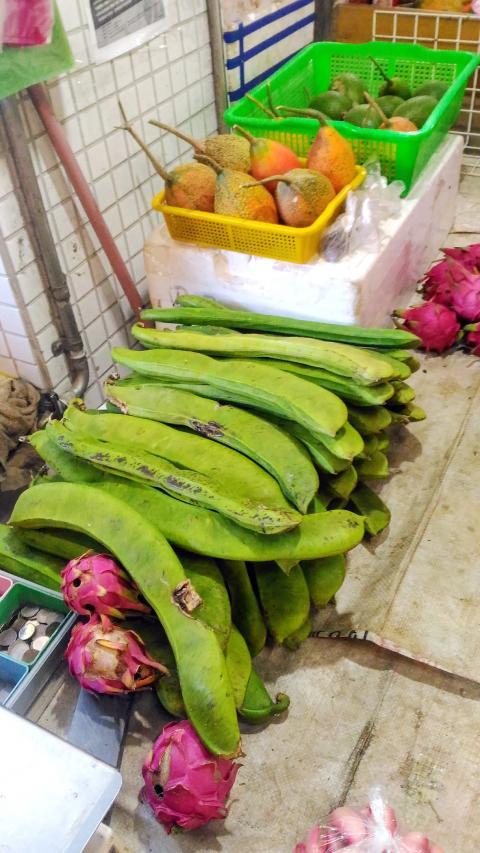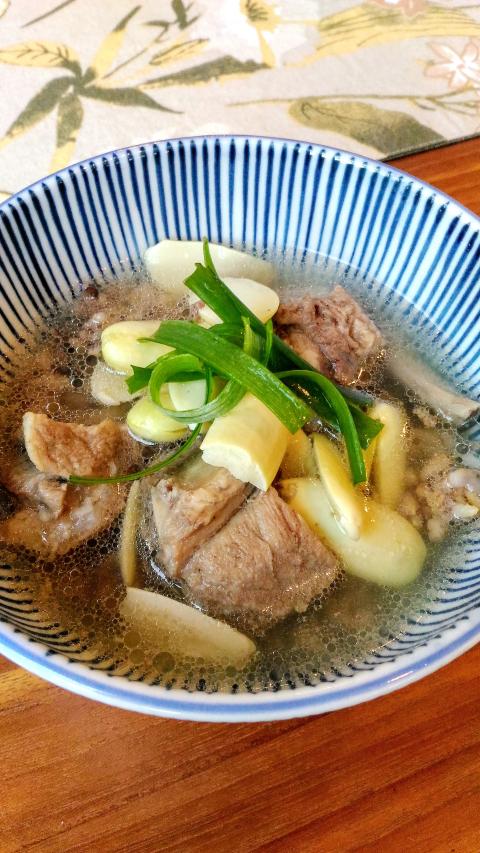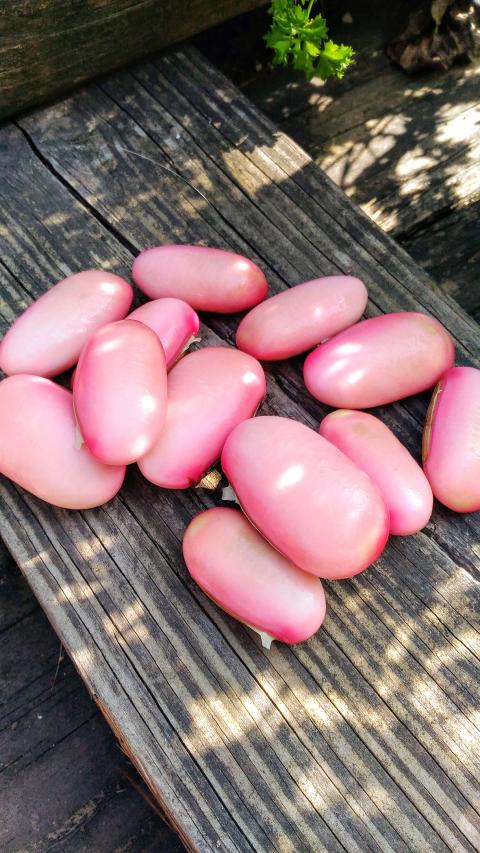With sudden heavy rains following on from weeks of torrid heat, farmers have taken a beating and the price of vegetables have shot up over the last month as the variety of local produce has dwindled. Down at my local market, small farmers spend much time indignantly protesting that they are not gauging customers, insisting that prices simply reflect the dearth of fresh vegetables. All kinds of unusual foraged wild vegetables are emerging as people seek a respite from the tedium of okra, bok choy and sweet potato leaves. This makes market shopping interesting, and this week I have embraced cooking with sword beans.
Sword beans (Canavalia gladiata) are notable for their large size, often over a foot in length. It is related to and similar to the common jack bean (Canavalia ensiformis). The lowly status of the jack bean is reflected in its other names, which include “pig bean” and “horse bean,” and in truth, one of the primary uses of this legume in western cultures is as green manure and animal feed. It was instructive that while researching the sword bean, the most detailed information was from the Web site Feedipedia, which describes itself as an “animal feed resources information system.” In Asian cultures, it is one of the bean types that is used in the production of sweet white bean paste (白豆沙), an important ingredient in Taiwanese-style moon cakes and other sweets.
It should be noted that some of the very best and nutritious vegetables available have been despised as only suitable for animal feed, not least sweet potato leaves and kohlrabi, both of which I have written about and which are now integral parts of my vegetable larder. These vegetables are often very hardy, able to survive harsh weather conditions and most significantly, due to their low status, do not warrant the expense of hormones, herbicides and pesticides to aid their growth. They are often a little more inconvenient to prepare, and the sword bean is a prime example of why this nutritious legume, which is well suited to Taiwan’s climate, is not readily available.

Photo: Ian Bartholomew
While most Taiwanese are familiar with the sword bean in its sweetened and pureed form, the fresh green is relatively rare, probably because making white bean paste is a labor intensive process that is now largely left to commercial manufacturers that generally use dried beans, which are much more convenient to transport and store.
As a fresh food, sword beans are not very promising. Shucking the legumes from their huge, stiff pods is laborious, and once the beans are obtained, a further thick casing needs to be removed before cooking. The casing is a lovely blush red when freshly removed from the pod, but rapidly oxidizes to an ugly blotchy and unappealing mauve. This casing is edible, but has a graininess that undermines the creamy texture of the bean. It also imparts a musty flavor, and while I found this rather appealing, the rest of my family were decidedly ambivalent.
The first time I cooked the beans I did not remove the casing because the man who sold them to me said that they only needed to be thrown in the pot. On a subsequent meeting, I suggested that the casing was not very nice to eat, he concurred:

Photo: Ian Bartholomew
“It’s not great, but whatever.”
Removing the casing, which is thick and stiff, is undemanding work, but slow. For all that, it should be removed before cooking, revealing a pale green bean slightly larger than a kidney bean. Even when the casing has oxidized as described above, the bean inside remains good and can keep well for a couple more days.
As an alternative to diversify a dull vegetable diet during the wet summer months when leaf vegetables are subjected to an overwhelming climatic and insect onslaught, sword beans are definitely a possibility if available. Feedipedia notes that the sword bean is a neglected crop with many unrealized benefits, quoting one scientific study that states: “The nutritional, pharmaceutical usefulness of this legume (sword beans) both to man and his livestock are outstanding; the seeds are used as food for man while foliage is important as meal for animals (Graham and Vance, 2003).”

Photos: Ian Bartholomew
The sword bean has recently come into focus as a powerful antioxidant and there was a flurry of reports in the local media last year that it might be particularly beneficial in the prevention of cystitis and other inflammations of the bladder.
While the sword bean is not likely to become a major food source, and has its share of inconvenience in regards to preparation, it should not be totally neglected for it has a lovely soft texture and a complex if subtle flavor profile that can be used in a variety of foods. I have never been a great fan of the sweet white bean paste, but even in savory preparations (see the recipe), it can also shine.
Pork rib soup with sword beans
Recipe
(serves 4)
This is a very simple dish that requires the freshest of ingredients. The quality of the pork is particularly important, and I strongly recommend using freshly killed pork (溫體豬) from a traditional butcher over frozen or supermarket meat. I have always got the best results this way as it is easily obtained from a good butcher at a traditional market. I have no scientific basis for this preference other than my own experience, but once frozen, pork seems to lose a little something in its flavor and its texture becomes a little less yielding. The beans, in my experience, are usually sold already shucked from the pods, but the outer casing of the bean should be removed before cooking, though this is not essential. The casings are said to contain many beneficial nutrients, but they undermine the flavor and texture of the final product. Served with a brown or mixed grain rice, the soup is a wonderful Asian twist to the powerful nutritional duo of rice and beans.
Ingredients
1kg pork neck, chopped (or other meaty rib cut)
200g sword beans, shucked
1 stem spring onion
Some cooked brown or multigrain rice (optional)
Salt and white pepper to season
Process1
1. Remove the casing from the sword beans with the help of a sharp knife.
2. Wash the pork neck thoroughly in cold water, removing most of the blood.
3. Place the pork in a pot and add water, just enough to almost cover the meat.
4. Over a medium flame, bring to a boil then turn the heat down to a low simmer. Use a ladle to skim off any scum that has formed on the surface.
5. Simmer for about 20 minutes. Add the beans and season with salt. Simmer for another 20 minutes.
6. Taste and adjust seasoning with more salt and white pepper. The pork should be soft and the beans just tender.
7. Serve over cooked rice and garnish with spring onions.
Ian Bartholomew runs Ian’s Table, a small guesthouse in Hualien. He has lived in Taiwan for many years writing about the food scene and has decided that until you look at farming, you know nothing about the food you eat.
He can be contacted at Hualien202@gmail.com.

Last month historian Stephen Wertheim of the Carnegie Endowment for International Peace published an opinion piece in the New York Times with suggestions for an “America First” foreign policy for Democratic presidential candidate Kamala Harris. Of course China and Taiwan received a mention. “Under presidents Trump and Biden,” Wertheim contends, “the world’s top two powers have descended into open rivalry, with tensions over Taiwan coming to the fore.” After complaining that Washington is militarizing the Taiwan issue, he argues that “In truth, Beijing has long proved willing to tolerate the island’s self-rule so long as Taiwan does not declare independence

Big changes are afoot in global politics, which that are having a big impact on the global order, look set to continue and have the potential to completely reshape it. In my previous column we examined the three macro megatrends impacting the entire planet: Technology, demographics and climate. Below are international trends that are social, political, geopolitical and economic. While there will be some impact on Taiwan from all four, it is likely the first two will be minor, but the second two will likely change the course of Taiwan’s history. The re-election of Donald Trump as president of the US

Nov. 25 to Dec. 1 The Dutch had a choice: join the indigenous Siraya of Sinkan Village (in today’s Tainan) on a headhunting mission or risk losing them as believers. Missionaries George Candidus and Robert Junius relayed their request to the Dutch governor, emphasizing that if they aided the Sinkan, the news would spread and more local inhabitants would be willing to embrace Christianity. Led by Nicolaes Couckebacker, chief factor of the trading post in Formosa, the party set out in December 1630 south toward the Makatao village of Tampsui (by today’s Gaoping River in Pingtung County), whose warriors had taken the

The Mountains to Sea National Greenway (山海圳國家綠道) draws its name from the idea that each hiker starting at the summit of Jade Mountain (玉山) and following the trail to the coast is like a single raindrop. Together, many raindrops form life and prosperity-bringing waterways. Replicating a raindrop’s journey holds poetic beauty, but all hikers know that climbing is infinitely more appealing, and so this installment picks up where the last one left off — heading inland and uphill along the 49.8-kilometer Canal Trail (大圳之路) — second of the Greenway’s four sections. A detailed map of the trail can be found